Modifying a Geological Model’s Boundary
Geological models are created with a basic set of rectangular extents that can then be refined using other data in the project. These extents usually correspond to the ground surface and known boundaries. Creating extents can also be used to restrict modelling to a particular area of interest; for example, modelling can be restricted to a known distance from wells by applying a distance function as a lateral extent. Extents do not need to be strictly vertical surfaces, and can be model volumes. It is also possible to define a base that serves as the geological model’s base.
When a topography is defined for the project, it will be automatically applied as a geological model’s upper boundary when the model is created.
The rest of this topic describes how to create and work with geological model extents. It is divided into:
- Creating Extents for a Geological Model
- Changing an Extent’s Settings
- Adding Data to an Extent
- Editing an Extent With a Polyline
- Editing an Extent With Structural Data
- Removing an Extent From a Geological Model
Creating Extents for a Geological Model
To create an extent, expand the geological model in the project tree. Right-click on the Boundary object and select from the New Lateral Extent or New Base options. Follow the prompts to create the extent, which will then appear in the project tree under the model’s Boundary object. For example, this geological model has two lateral extents, one from a polyline and the other from GIS data:

New extents are automatically applied to the boundary being modified. Leapfrog Geothermal usually orients a new extent correctly, with red presenting the inside face of the extent and blue representing the outside face. If this is not the case, you can change the orientation by right-clicking on the extent in the project tree and selecting Swap Inside.
Extent From a Polyline
You can create an extent from a polyline that already exists in the project or you can draw a new one. If you want to use an imported polyline, import it into the Polylines folder before creating the new extent.
To create a new extent from a polyline, right-click on the model’s Boundary object and select New Lateral Extent > From Polyline or New Base > From Polyline. In the window that appears, select whether you will create a new polyline or use an existing one:
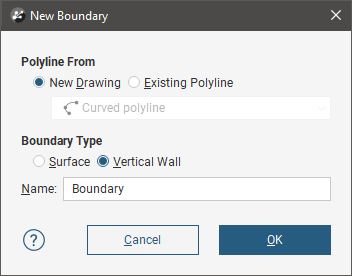
For lateral extents, you can create the extent as a Vertical Wall or Surface. If you create the lateral extent as a Surface, you will be able to modify it using additional data, as described below. A lateral extent created as a Vertical Wall, however, cannot be modified. A base is always created as a surface and so can be modified as described below.
Click OK to generate the new extent. If you have chosen to create a New Drawing, the drawing controls will appear in the scene and you can begin drawing, as described in Drawing in the Scene.
The new extent will appear in the project tree as part of the Boundary object.
If the surface generated does not fit the polyline adequately, you can increase the quality of the fit by adding more points to the polyline. See Drawing in the Scene for information on adding points to polylines.
Extents created from polylines can be modified by adding points data, GIS vector data and structural data. You can also add polylines and structural data to the extent. See Adding Data to an Extent, Editing an Extent With a Polyline and Editing an Extent With Structural Data for more information.
Extent From GIS Vector Data
GIS data in the project can be used to create a lateral extent or a base for a geological model. Once the data you wish to use has been imported into the project, right-click on the model’s Boundary object and select New Lateral Extent > From GIS Vector Data or New Base > From GIS Vector Data.
In the window that appears, select the data object you wish to use:
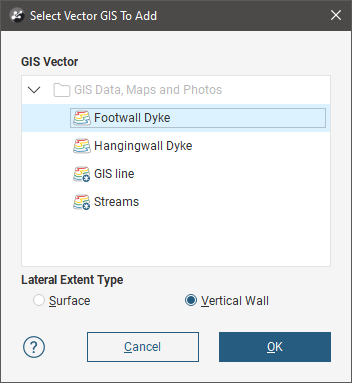
For lateral extents, you can create the extent as a Vertical Wall or Surface. If you create the lateral extent as a Surface, you will be able to modify it using additional data, as described below. A lateral extent created as a Vertical Wall, however, cannot be modified. A base is always created as a surface and so can be modified as described below.
If you select the Surface option, you can use the GIS data object with its own elevation data or projected onto the topography:

Using the On Topography option makes sense for GIS data as it is, by nature, on the topography. The On Topography option also mitigates any issues that may occur if elevation information in the GIS data object conflicts with that in the project.
Click OK to create the new extent. The new extent will appear in the project tree as part of the Boundary object.
Extents created from GIS data can be modified by adding points data, GIS vector data and structural data. You can also add polylines and structural data to the extent. See Adding Data to an Extent, Editing an Extent With a Polyline and Editing an Extent With Structural Data for more information.
Extent From Points
To create a new extent from points data, right-click on the Boundary object for the model you are working on and select New Lateral Extent > From Points or New Base > From Points. The Select Points To Add window will be displayed, showing points data available in the project:

Select the information you wish to use and click OK.
The new extent will appear in the project tree as part of the Boundary object.
Extents created from points can be modified by adding points data, GIS vector data and structural data. You can also add polylines and structural data to the extent. See Adding Data to an Extent, Editing an Extent With a Polyline and Editing an Extent With Structural Data for more information.
Extent From Structural Data
Planar structural data can be used to create a lateral extent or a base for a geological model. You can create a new structural data table or use a table that already exists in the project. If you want to use categories of structural data in creating the extent, use an existing table and create filters for those categories before creating the lateral extent.
To start, right-click on the Boundary object for the model you are working on and select New Lateral Extent > From Structural Data or New Base > From Structural Data. The New Structural Data window will be displayed, showing structural data available in the project:

Select the New Drawing option to draw the structural data points directly in the scene.
Select the Existing Structural Data option to use a table in the Structural Modelling folder. With this option, you will be able to select from the categories available in the data table, if query filters have been created for those categories:

Click OK to generate the new extent. If you have chosen to create a New Drawing, the drawing controls will appear in the scene and you can begin drawing, as described in Creating New Planar Structural Data Tables. To share the new structural data table, right-click on it and select Share. The table will be saved to the Structural Modelling folder.
The new extent will appear in the project tree as part of the Boundary object.
Extents created from structural data can be modified by adding points data, GIS vector data and structural data. You can also add polylines and structural data to the extent. See Adding Data to an Extent, Editing an Extent With a Polyline and Editing an Extent With Structural Data for more information.
Extent From a Surface
To use a surface as an extent for a geological model, right-click on the model’s Boundary object and select New Lateral Extent > From Surface or New Base > From Surface. The Select Boundary window will appear, showing all the meshes that can be used as an extent:
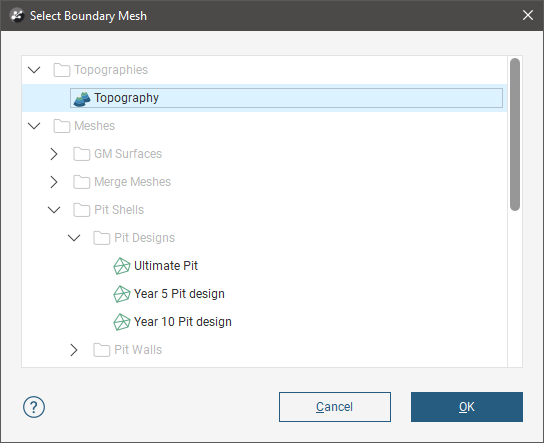
Select the required mesh and click OK. The extent will be added to the model’s Boundary object.
You cannot modify an extent created from a mesh by adding data, editing with polylines or structural data or by applying a trend. However, the extent is linked to the mesh used to create it, and updating the mesh will update the extent.
Extent From Distance to Points
Leapfrog Geothermal can calculate the distance to set of points and use the resulting distance buffer as a lateral extent for a geological model. To create a new lateral extent from a distance buffer, right-click on the Boundary object for the model you are working on and select New Lateral Extent > From Distance To Points. The Smoothed Distance Buffer window will appear:
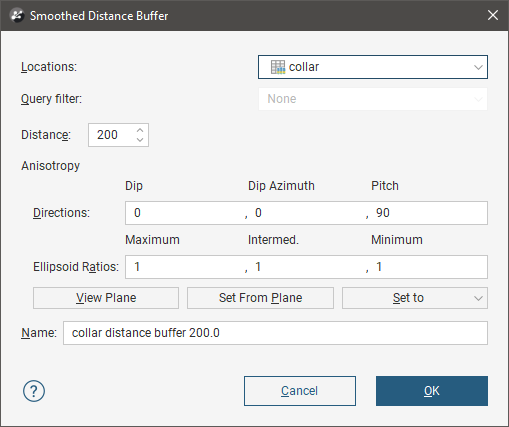
Select the Distance and set an Anisotropy, if required.
The Ellipsoid Ratios determine the relative shape and strength of the ellipsoids in the scene, where:
- The Maximum value is the relative strength in the direction of the green line on the moving plane.
- The Intermed. value is the relative strength in the direction perpendicular to the green line on the moving plane.
- The Minimum value is the relative strength in the direction orthogonal to the plane.
You can also use the Set to list to choose different options Leapfrog Geothermal has generated based on the data used to build the model. Isotropic is the default option used when the model is created.
Click OK to create the new extent, which will appear in the project tree as part of the Boundary object.
To change the extent’s settings, expand the model’s Boundary object in the project tree and double-click on the extent. Adjust the Distance and Anisotropy, if required.
The resolution of extents is automatically inherited from the geological model. You can change the resolution for an extent if you want more or less detail than for the geological model as a whole. To do so, untick the box for Inherit resolution from GM and change the setting.
Extents created from a distance to points function can be modified by adding points data and GIS vector data. See Adding Data to an Extent.
Extent From a Distance Function
A distance function calculates the distance to a set of points and can be used to bound a geological model. You can use an existing distance function as a lateral extent or create a new one.
To use a distance function as a lateral extent, right-click on the Boundary object for the model you are working on and select New Lateral Extent > From Distance Function. If there are no distance functions in the project, you will be prompted to create a new one. See Distance Functions for information on defining and editing the distance function.
When there are already distance functions in the project, you will be prompted to choose between creating a new function or using an existing one:
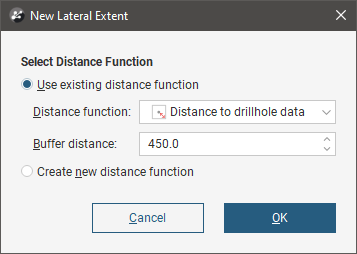
To use an existing function, select it from the list and set a Buffer distance. Click OK to create the lateral extent.
When you create a new distance function, it will be part of the model’s Boundary object and will not be available elsewhere in the project. To share it within the project, expand the lateral extent in the project tree and right-click on the distance function. Select Share. The distance function will be saved to the Numeric Models folder.
To change the extent’s settings, expand the model’s Boundary object in the project tree and double-click on the extent. The Edit Distance Buffer window will appear.
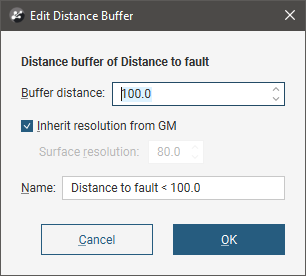
The resolution of extents is automatically inherited from the geological model. You can change the resolution for an extent if you want more or less detail than for the geological model as a whole. To do so, untick the box for Inherit resolution from GM and change the setting.
Base From Lithology Contacts
To create a base from lithlogy contacts, right-click on the Boundary object and select either New Base > From Base Lithology or New Base > From Other Contacts.
The only difference in the two methods is that when creating a base from other contacts, you must first select the lithology column from those available in the project.
When defining the base, select the primary lithology and the contacts to use:
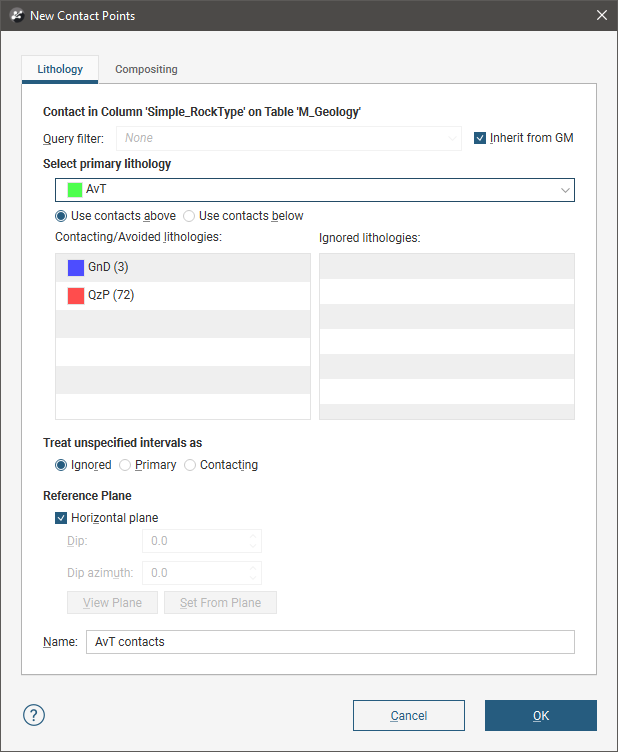
For complex geologies, the up and down directions for the base may not be clear. If this is the case, untick the Horizontal Plane box. A reference plane will appear in the scene, with the up-facing surface labelled A and the downward-facing surface labelled B. Controlling the position of the reference plane is similar to controlling the position of the moving plane:
- Use the handles in the scene window to move the plane.
- Set the Dip and Dip Azimuth values in the New Contact Points window. The reference plane will be updated in the scene.
When you disable the Horizontal plane option for the Reference Surface, the number of contacts is longer displayed in the lithologies lists, as the number of contact points is not updated when the reference surface used changes.
Once the reference plane is correctly oriented, click the Set From Plane button.
Click OK to create the base, which will appear under the Boundary object. The new base will automatically be added to the model.
Each geological model can have only one base defined, so if you wish to define a new base, you must first delete the existing base from the model. Do this by right-clicking on the Base object and selecting Delete. You can also choose not to use the base you have defined. See Removing an Extent From a Geological Model for more information.
Changing an Extent’s Settings
For geological model extents created from polylines, GIS data, points and structural data, you can change the extent’s settings by double-clicking on it in the project tree.

In the Surfacing tab, you can change surface resolution and contact honouring options, which are described below. In the Trend tab, you can apply a trend to the extent, which is described in Applying a Trend.
Surface Resolution
For geological models, the resolution of extents and whether or not the adaptive isosurfacer is used is automatically inherited from the geological model. You can change these settings for an extent if you want more or less detail than for the geological model as a whole. To do so, untick the box for Inherit resolution from GM and make the required changes.
Contact Honouring
Often, surfaces should honour well data and treat data objects such as polylines and GIS data as interpretations. For extents, the Snap to data setting in the Surfacing tab determines whether or not the extent honours the data used to create it. Options are:
- Off. The extent does not snap to the data used to create it. This is the default setting.
- All data. The extent snaps to all data within the Maximum snap distance, which includes well data and any data added to the extent.
- Drilling only. The extent snaps to well data and data objects derived from well data within the Maximum snap distance, but not to other data used to modify the extent. For example, the extent will honour points data derived from well data, but not points data imported into the Points folder.
- Custom. The extent snaps to the data objects indicated in the Inputs tab that are within the Maximum snap distance.
Take care in enabling snapping and in selecting what data the surface will snap to, as the more data you include, e.g. by setting a large Maximum snap distance or selecting All data for Snap to data, the greater the possibility that errors in the data or assumptions inherent in interpretations (e.g. polylines) will cause distortions in the meshes. If you do enable snapping, it is best to snap only to drilling data. See Honouring Surface Contacts for more information on these settings.
The snap setting for the geological model will be used if Snap to data is set to Inherit from GM.
Whatever the setting, you can see what objects are snapped to by clicking on the Inputs tab.
If you need the extent to honour well data but treat other data objects as interpretations, select Drilling only. To honour some data objects while treating others as interpretations, select Custom, then click on the Inputs tab to enable snapping for individual objects.
Applying a Trend
You can adjust an extent created from polylines, GIS data, points and structural data by applying a trend to it. To do this, add the extent to the scene. Next, double-click on the extent in the project tree and click the Trend tab.
Often the easiest way to apply a trend is to click on the Draw plane line button (![]() ) and draw a plane line in the scene in the direction in which you wish to adjust the surface. You may need to rotate the scene to see the plane properly.
) and draw a plane line in the scene in the direction in which you wish to adjust the surface. You may need to rotate the scene to see the plane properly.
The Ellipsoid Ratios determine the relative shape and strength of the ellipsoids in the scene, where:
- The Maximum value is the relative strength in the direction of the green line on the moving plane.
- The Intermed. value is the relative strength in the direction perpendicular to the green line on the moving plane.
- The Minimum value is the relative strength in the direction orthogonal to the plane.
Once you have adjusted the plane to represent the trend you wish to use, click the Set From Plane button to copy the moving plane settings.
The Set to list contains a number of different options Leapfrog Geothermal has generated based on the data used in the project. Isotropic is the default option used when the extent was created. Settings made to other surfaces in the project will also be listed, which makes it easy to apply the same settings to many surfaces.
Click OK to apply the changes.
See Global Trends for more information.
Adding Data to an Extent
Extents created from polylines, GIS data, points and structural data can be modified by adding points data objects, GIS vector data and structural data. Extents created from a distance to points function can be modified by adding points data and GIS vector data. To add data to an extent, right-click on the extent in the project tree and select the data type you wish to use from the Add menu.
- Points data. Select from the points data objects available in the project and click OK.
- GIS vector data. Select from the GIS vector data available in the project and click OK.
- Structural data. Select from the structural data tables available in the project. If the selected table has query filters defined, you can apply one of these filters by selecting the required query from the list. Click OK to add the selected data to the extent. An alternative to adding an existing structural data table to an extent is to edit the extent with structural data. This is described in Editing an Extent With Structural Data below.
You can also add a polyline that already exists in the project. To do this, right-click on the extent in the project tree and select Add > Polyline. You will be prompted to choose from the polylines in the Polylines folder.
Editing an Extent With a Polyline
You can edit an extent using a polyline, which is described in Editing Surfaces With Polylines. A polyline used to edit an extent will be added to the project tree as part of the extent. To edit the polyline, right-click on it and select Edit Polyline or add it to the scene and click the Edit button (![]() ) in the shape list. If you wish to remove the polyline from the extent, right-click on it in the project tree and select Delete or Remove.
) in the shape list. If you wish to remove the polyline from the extent, right-click on it in the project tree and select Delete or Remove.
To add an existing polyline to a geological model extent, use the Add > Polyline option.
Editing an Extent With Structural Data
You can edit an extent using structural data, which is described in Editing Surfaces With Structural Data. A structural data table will be added to the project tree as part of the extent. To edit the table, right-click on it and select Edit In Scene or add it to the scene and click the Edit button (![]() ) in the shape list. If you wish to remove the table from the extent, right-click on it in the project tree and select Delete or Remove.
) in the shape list. If you wish to remove the table from the extent, right-click on it in the project tree and select Delete or Remove.
Removing an Extent From a Geological Model
If you have defined an extent and want to remove it from the model, there are two options. The first is to right-click on the extent in the project tree and click Delete. This deletes the extent from the model, but does not delete parent objects from the project unless they were created as part of the model, e.g. a polyline used as a lateral extent but not shared within the project. Use this option only if you are sure you do not want to use the extent.
The second method is useful if you are making changes to the extent and do not want to recompute the model with each change. Double-click on the model’s Boundary object or double-click on the model and click on the Boundary tab. The Boundaries part of the window lists all objects used as extents for a geological model:
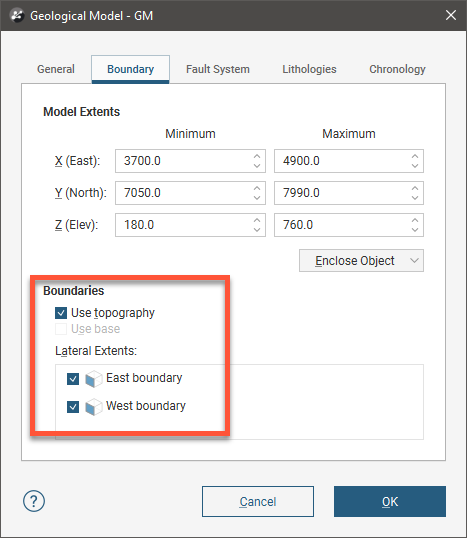
Untick the box for extents to temporarily disable them in the model. The model will be reprocessed, but you can then work on the extent without reprocessing the model. Disabled extents will be marked as inactive in the project tree:
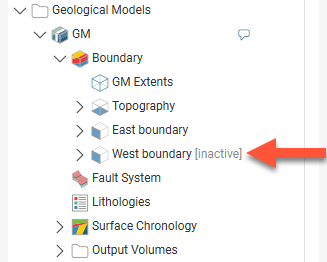
Got a question? Visit the Seequent forums or Seequent support